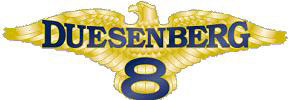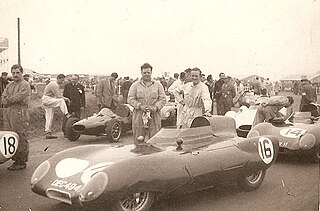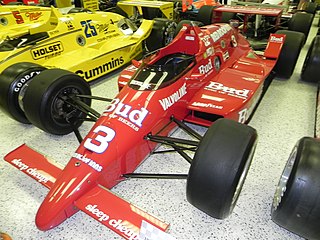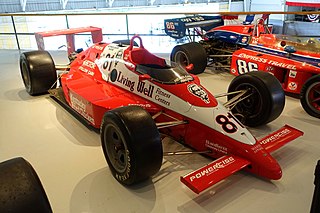Related Research Articles

The Ford GT40 is a high-performance endurance racing car commissioned by the Ford Motor Company. It grew out of the "Ford GT" project, an effort to compete in European long-distance sports car races, against Ferrari, which won the prestigious 24 Hours of Le Mans race from 1960 to 1965. Ford succeeded with the GT40, winning the 1966 through 1969 races.

The Indianapolis 500, also formally known as the Indianapolis 500-Mile Race, or simply the Indy 500, is an annual automobile race held at Indianapolis Motor Speedway (IMS) in Speedway, Indiana, United States, an enclave suburb of Indianapolis. The event is traditionally held over Memorial Day weekend, usually the last weekend of May.

Motorsport, motorsports or motor sport is a global term used to encompass the group of competitive sporting events which primarily involve the use of motorised vehicles. The terminology can also be used to describe forms of competition of two-wheeled motorised vehicles under the banner of motorcycle racing, and includes off-road racing such as motocross.

The Cooper Car Company is a British car manufacturer founded in December 1947 by Charles Cooper and his son John Cooper. Together with John's boyhood friend, Eric Brandon, they began by building racing cars in Charles's small garage in Surbiton, Surrey, England, in 1946. Through the 1950s and early 1960s they reached motor racing's highest levels as their rear-engined, single-seat cars competed in both Formula One and the Indianapolis 500, and their Mini Cooper dominated rally racing. The Cooper name lives on in the Cooper versions of the Mini production cars that are built in England, but is now owned and marketed by BMW.

Duesenberg Automobile and Motors Company, Inc. was an American racing and luxury automobile manufacturer founded in Indianapolis, Indiana by brothers Frederick and August Duesenberg in 1920. The company is known for popularizing the straight-eight engine and four-wheel hydraulic brakes. A Duesenberg car was the first American car to win the 1921 French Grand Prix and Duesenbergs won the Indianapolis 500 in 1924, 1925, and 1927. Transportation executive Errett Lobban Cord acquired the Duesenberg corporation in 1926. The company was sold and dissolved in 1937.
The Ferrari P was a series of Italian sports prototype racing cars produced by Ferrari during the 1960s and early 1970s.

The Alfa Romeo 33 Stradale is a mid-engined sports car built by Italian car manufacturer Alfa Romeo. It is one of the world's first supercars; it was the fastest commercially available car for the standing kilometer when introduced. 18 examples were produced between 1967 and 1969. "Stradale" is a term often used by Italian car manufacturers to indicate a street-legal version of a racing car; indeed the 33 Stradale was derived from the Tipo 33 sports prototype.
The Cooper Tires USF2000 Championship is an American racing series using the American variation of the Formula Ford formula, "F2000", that resumed operation for the 2010 season. As of 2022, it is sanctioned by the United States Auto Club, and is the first rung of the Road to Indy.

The 2012 IZOD IndyCar Series was the 17th season of the IndyCar Series, and the 101st season of American open wheel racing. Its premier event was the 96th Indianapolis 500, held on Sunday, May 27. The series was sanctioned by IndyCar, and took place in three countries on two continents. Chevrolet returned to the series for the first time since 2005 while Lotus debuted, with the latter leaving the IndyCar Series after the 2012 season due to poor performance.

John Crosthwaite was an English race car designer and engineer, active in both the United Kingdom and the United States.
Colin Jordan Seeley was a British motorcycle retailer who later became a motorcycle sidecar racer, motorcycle designer, constructor and retailer of accessories. In 1992 he was involved in running the Norton Rotary race team.

The Dallara DW12 is an open-wheel formula racing car developed and produced by Italian manufacturer Dallara for use in the IndyCar Series. It was developed for use in the 2012 IndyCar Series season, replacing the aging Dallara IR-05 chassis and scheduled will be used until at least 2024 season. The chassis is named after Dan Wheldon, who was the car's test driver, and who was killed at Las Vegas Motor Speedway on October 16, 2011, the final race of the previous IR-05.
Don Parker was a British racing driver from England who was British Formula Three Champion on three occasions. He also competed in the British Saloon Car Championship.

The March 85C is a highly successful and extremely competitive open-wheel race car, designed by Adrian Newey, and built by March Engineering, to compete in the 1985 IndyCar season. The season was a white-wash and a clean-sweep for March, winning 10 out of the 15 races, and taking 12 pole positions. Newey's March 85C chassis successfully clinched the 1985 IndyCar championship in the hands of Al Unser, and the 1985 Indianapolis 500 with Danny Sullivan, with his famous last-lap "spin-and-win." It was powered by the Buick Indy V6 turbo engine, which powered Pancho Carter to pole position, and Scott Brayton to second position at the Indianapolis 500, sweeping the top two spots, and the Ford-Cosworth DFX turbo V8 engine.

The March 86C is a highly successful and extremely competitive open-wheel race car, designed by Adrian Newey, and built by March Engineering, to compete in the 1986 IndyCar season, and eventually the 1987 IndyCar season. The season was another whitewash and a clean-sweep for March, following up on the success of their 1985 campaign. The 86C chassis dominated the season, winning 14 out of the 17 races, and taking 13 pole positions. Newey's March 86C chassis successfully clinched the 1986 IndyCar championship and the 1986 Indianapolis 500 with Bobby Rahal. It was primarily powered by the Ford-Cosworth DFX turbo V8 engine, but also used both the Buick Indy V6 turbo engine, and the Ilmor-Chevrolet 265-A Indy V8 turbo engine.

The March 87C is a highly successful and extremely competitive open-wheel race car, designed and built by March Engineering, to compete in the 1986 IndyCar season, alongside the 85C and 86C. The season was another whitewash and a clean-sweep for March, following up on the success of their 1986 campaign. The 86C chassis dominated the season, winning 9 out of the 15 races, and taking 8 pole positions. The March 87C chassis successfully clinched the 1986 IndyCar championship with Bobby Rahal, and the 1987 Indianapolis 500, with Al Unser. It was powered by the Cosworth DFX turbo engine like its predecessors.

The March 783 and March 793 are open-wheel Formula 3 race car chassis', designed, developed, and built by March Engineering between 1978 and 1979. They are very similar in design, with the 793 essentially being a ground effect version of the 783; with lower side pods and skirts. Between them, they won a total of 24 races, including three non-championship races in 1979, with Kenny Acheson. The 793 chassis in particular was extremely successful, and completely dominated the 1979 season, with Brazilian Chico Serra clinching the 1979 British Formula Three Championship, after winning 5 out of the 20 races. Italian Andrea de Cesaris was runner-up, placing second in the championship; having also won 5 races with the March 793. New Zealander Mike Thackwell placed third in the championship, having won 4 races with the March 793 chassis. They were powered by either a Toyota or Triumph four-cylinder engine.
The Sauber C1 was the first racing car that the Swiss Peter Sauber designed and built in 1970 at the age of 26 in his parents' basement in Zurich.
The Cooper T87 is a special purpose-built open-wheel race car, originally built by British manufacturer Cooper Cars, that was designed and developed by British racing driver and engineer Martin Brain, specifically for both hillclimb racing and Formula Libre competitions, in 1967. The car itself was based around a Formula 2 chassis, and was equipped with a naturally aspirated 2.5 L (150 cu in) Daimler SP 250, usually found in a Daimler 250, which produced 142 hp (106 kW). It competed in a number of races and events, before it was sold to Clive Oakley, who continued to use it in its original guise for a while, before later fitting it with a 3.5 L (210 cu in) Rover V8. Brain had previously fitted a 440 cu in (7.2 L) Chrysler V8 engine to a Cooper T81 Formula One car chassis.
References
- ↑ "Cooper Cars". June 23, 2010. Archived from the original on June 13, 2022. Retrieved June 18, 2022.
- ↑ "Cooper". 500race.org. Archived from the original on 2022-01-29. Retrieved 2022-06-18.
- ↑ "1947 Mk I (T4)". 500race.org. Archived from the original on 2022-01-29. Retrieved 2022-06-18.
- ↑ "Triumph". 500race.org. Archived from the original on 2022-01-29. Retrieved 2022-06-18.
- ↑ "Cooper History". www.coopercarcompany.com. Archived from the original on 2021-02-27. Retrieved 2022-06-18.